Carlsen Hangs on in Game 6
The World Champion, Magnus Carlsen and challenger Fabiano Caruana tied at 3-3 at half time in the World Championship match in London

It is a truth universally acknowledged, that a World Championship match which starts with a run of draws will see that run broken by a win from the challenger.
In his 1995 match against Garry Kasparov, Viswanathan Anand scored the first win in game 9, in 2016 Sergey Karjakin broke through against Magnus Carlsen in game 8, and Boris Gelfand followed six draws against World Champion Anand with a game 7 win in 2012. (Did I mention that after these deadlock-breaking wins, the challengers did not win another game and all lost their matches?)
After five consecutive draws at the world title match in London, US challenger Fabiano Caruana went as close as humanly possible to taking the lead against Carlsen in the sixth game but was stymied by heroic defence by the World Champion. The game ended in a draw after more than 6 hours and 80 moves, leaving the match score tied at 3-3 and a capacity crowd heading home more than entertained.
Many had been at the venue for more than eight hours as an hour before the sixth game began the queue to enter the venue was more than 50 strong, stretching along Theobalds Road.
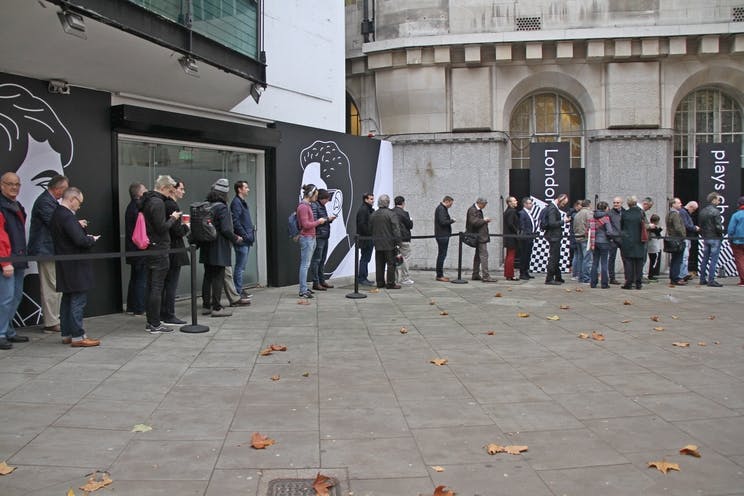
The Queue outside the venue. Photo: Cathy Rogers
For a match which had so far featured five draws, some of them lacking much content, the public interest in London might be considered surprising. However it is 18 years since the World Championship has been hosted in England and interviews with the spectators, including the many pre-teens here with parents, constantly throw up the comment that it is special just to be in the same room as the world’s top players while they compete for the top title.
After a modest turnout on day one – partially compensated by an excess of press and VIPs, the crowds at The College in Holborn have been consistently high. Indeed so many tickets have been sold (around 300) that at any one time 50 spectators are without seats; there are only 150 in the playing theatre and 40 in Judit Polgar and Anna Rudolf’s commentary room, with standing no longer allowed in either. (‘Health and safety rules’ say the security guards.)
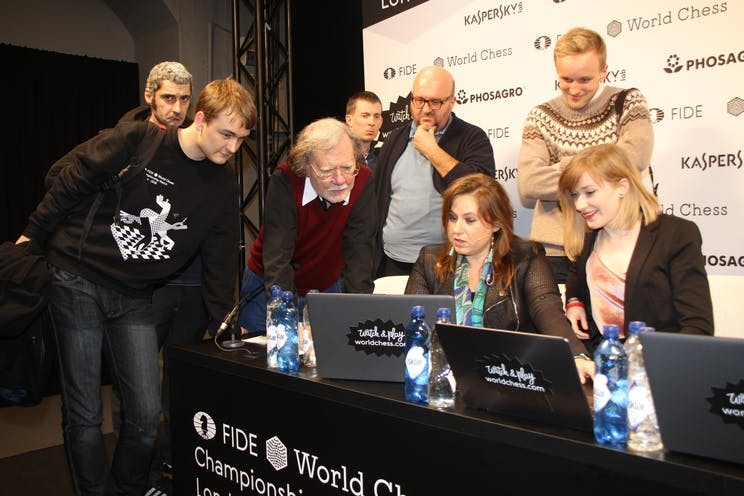
Various media members reviewing the game. Photo: Cathy Rogers
Those admitted, both with ‘cheap’ 55 pound tickets and with 400 pound VIP tickets, must sit on wooden boxes, ensuring that not too many mind when they are moved on after half an hour. The time share policy, launched without warning last Saturday, caused some angst but now visitors with general admission tickets are warned that they will only be allowed into the main theatre to watch the players in half hour shifts.
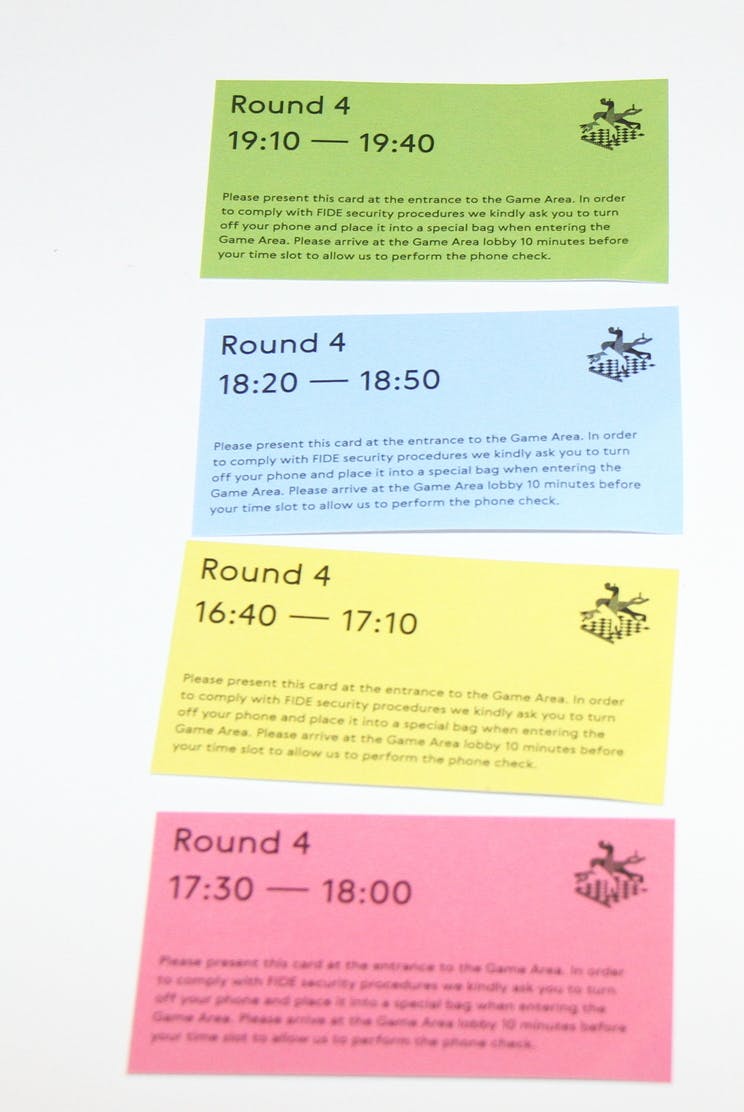
Tickets to the event with 30 minute time slots. Photo: Cathy Rogers
However the venue is simply not suitable for older and less able spectators, and some were far from pleased.
Nonetheless, on Friday every room except the gift shop was full, including the standing-room-only cafe and the corridor.
Remarkably, six hours after the start of the game, the playing hall and the commentary room were still overflowing, and the tired security guards had given up preventing people from standing in the aisles.
The fans at The College ended up watching an epic, yet at first the game had looked as if it would be as much of a fizzer as Carlsen’s previous effort with White in game 4. (In between had been a briefly exciting game 5, where Caruana tried to disrupt Carlsen with a rare gambit but found his opponent exceptionally well prepared.)
Carlsen’s switch to 1.e4 was expected by many. Given the information exposed in the infamous Saint Louis Chess Club video about Caruana, the Norwegian could be confident that Caruana was likely to stay with his Petroff’s Defence (rather than unleash a new weapon) and so could use the best of his pre-match preparation.
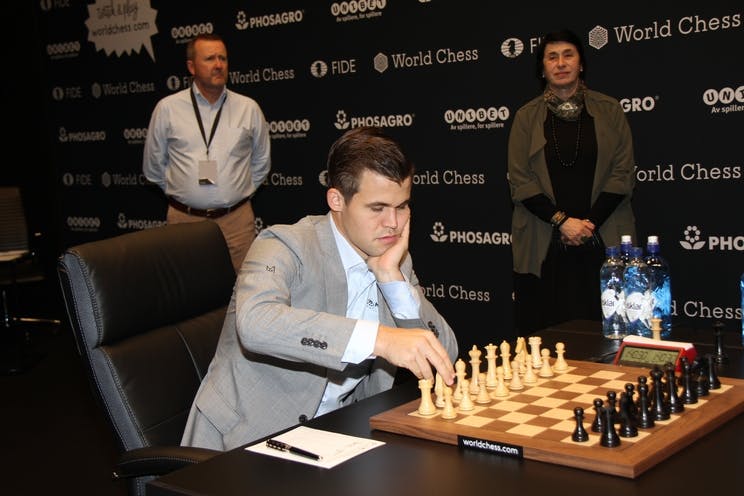
World Champion Magnus Carlsen. Photo: Cathy Rogers
However if the anti-Petroff line used by Carlsen is the best his team has got, then Caruana can keep playing the opening happily. After comfortably neutralising a light Carlsen initiative, Caruana managed to outplay his opponent in a dry endgame – just the type of position where the Carlsen of old excelled. (At the round 5 press conference Carlsen had admitted that his favourite player from the past was …. himself from 4 years ago!)
After the first time control Carlsen was induced to sacrifice a piece for three pawns, which turned out to be only two. The resultant position divided opinions, but the endgame experts in the press room, veteran English Grandmasters Jon Speelman and Jonathan Mestel, decided quite early that Carlsen had good chances to set up an unbreachable fortress. Watching those two analyse was a throwback to World Championships of old when GMs shared ideas without keeping one eye on a computer screen in case it jumps from 0.1 to 0.2 advantage. (Computers tend to have no idea about fortresses, misjudging one side to have a substantial advantage even when the draw is obvious to humans.)
Sure enough, Carlsen found the set-up foreseen by Speelman and Mestel, with only one pawn for the piece but where Caruana could make no progress. There was one glitch in the matrix, a brief moment where Caruana could reposition his pieces to break down Carlsen’s defences – which caused the computer to cry out for a mate in 30 - but by then, Caruana admitted he had already mentally conceded the half point. (A member of Caruana’s team promptly declared that this game ‘proved’ that Caruana was unaffected by the Saint Louis Chess Club video release. Well, maybe.)
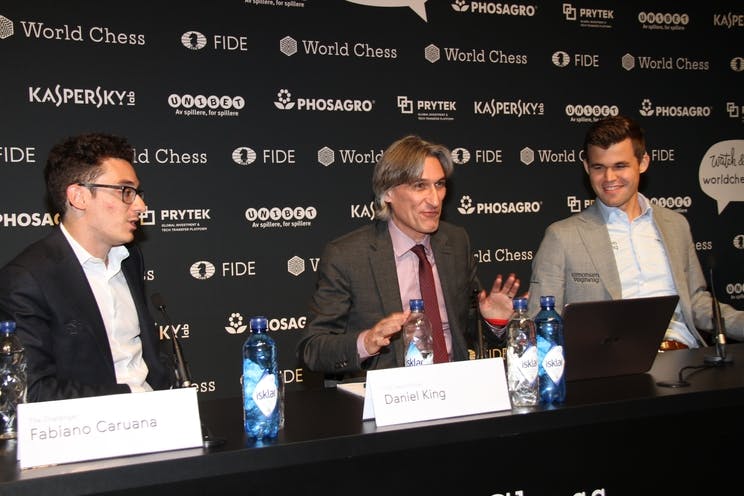
Fabiano Caruana, Daniel King and Magnus Carlsen. Photo: Cathy Rogers
When the two players arrived at the press conference after the game they were greeted with a thunderous round of applause. Press officer, Daniel King kept the questioning brief, not only because the players were exhausted but also because they were about to be required to perform again, this time for the obligatory drug tests.
As was evident from the pre-match training videos released by each side, neither player has been training to win the Tour de France or trying to become part-time body builders, so they are expected to return negative readings when the results eventually come back, long after the match has concluded. Many drugs that might be minimally useful for chessplayers such as caffeine and nicotine are legal, although the ‘smart drug’ modafinil is now on the banned list.
The players will enjoy a rest day on Saturday before resuming battle on Sunday. At half time it is impossible to pick a favourite. Carlsen missed plenty of chances in game 1 but since then has generated very little. Caruana, on the other hand, has created genuine chances only in game 6 but Carlsen’s last line of defence proved just good enough to hold. Most likely the match will hang on a single error, which becomes more likely as the tension rises and the players become more tired.
https://lichess.org/study/80Xf3Bdb/jBIAZagU
https://lichess.org/study/80Xf3Bdb/alndlaH8
Game 7 starts at 15:00 GMT on Sunday. You can watch the games live here.
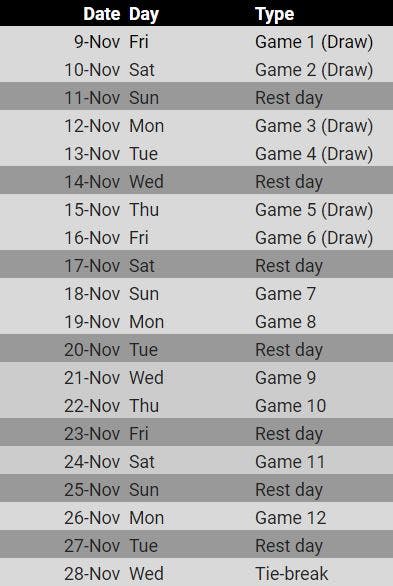
Stay tuned to our standard communication channels for details: